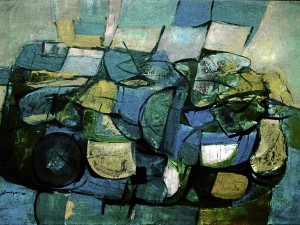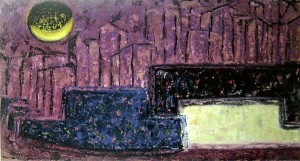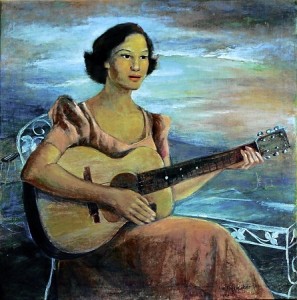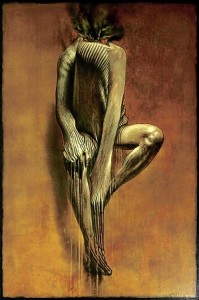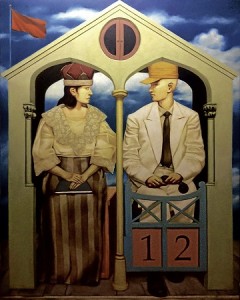Buyers snap up works of PH artists
During the Important Philippine Art auction held by Salcedo Auctions on Sept. 22, Anita Magsaysay-Ho’s 1950 oil painting “Lady with Guitar” sold for P6.307 million, a whopping 425 percent over the painting’s estimated value of P1.2 million to P1.4 million.
Ronald Ventura’s “Burnout”, meanwhile, topped the estimate by an even higher margin of 569 percent. The 2005 oil on canvas with collage sold for a hefty P5.022 million, far exceeding the estimate of between P750,000 and P850,000 for the piece measuring 90.7 centimeters by 60.7 centimeters.
According to Karen Kua-Lerma, president of Salcedo Auctions, the “tremendous upsurge” in the prices that both foreign and local buyers are willing to pay for Philippine art indicated the growing reputation of Philippine artists in the international art scene, as the country’s own image abroad has improved dramatically since the Aquino administration took over in 2010.
“It was not so long ago when news of a painting by a Filipino artist selling for P3 million was such a big deal. But now prices are rising and there seems to be no end to the increase,” says Karen, who put up Salcedo Auctions with husband, Ramon, in February 2010.
Karen points out that, apart from Filipinos who are either long-time art collectors or are looking to put a stamp on their growing wealth by collecting pieces of art, many foreigners also participated in the auction last Sept. 22.
Article continues after this advertisementMost foreign and local buyers collect these pieces with the hope that they will appreciate significantly in value down the road—much like how investors put their money in stocks with the intent of selling them later at a significant premium.
Article continues after this advertisementFor these speculators, contemporary art pieces by young artists such as Ventura and Jose John Santos III are attractive because these present the best chances of appreciating significantly in value in just a few years.
Ramon, who is advisor of Salcedo Auctions and chief curator of the Ateneo Art Gallery, explains that these exponents of contemporary art are interesting to collectors because the prices they command are not yet fixed, and are in fact trending higher.
He compares them to speculative stocks on the Philippine Stock Exchange. There is great risk in purchasing these stocks issued by companies whose track record still needs to be tested. But they also promise the highest reward when and if their potential is unleashed.
The works of National Artists, on the other hand, are more like the so-called blue chip stocks. The prices are set, appreciation is slow, but there is also very little risk of prices plummeting since there is general agreement on how much the art pieces are worth.
During the auction, for example, the 1957 piece of National Artist Jose Joya was sold for P1.868 million, not far from the high end of the 57.2 cm by 86.4 cm oil painting’s estimated value of P1.2 to P1.5 million.
Ramon explains that there are no hard and fast rules when it comes to putting a value to a piece of art as there are many factors that come into play, not the least of which is taste.
“Besides what the art piece represents, people are also looking at credentials. Ronald Ventura, for example, did not just pop out of the woodwork. He is critically acclaimed and he has won a number of awards,” says Ramon.
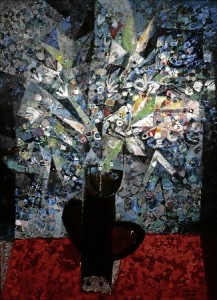
Mauro Malang Santos’ oil on canvas, “Still Life with Vase and Flowers” (1980), was sold for P934,400.
The value of the artwork of contemporary artists, he says, is mainly created by four art advocates. These are the institutions that give out awards or museums that mount exhibits; the commercial art market, or the galleries and auction houses that sell the pieces; reputable private collectors and finally the art critics.
The value, however, is ultimately decided by the buyer.
“You cannot really put a peso sign on the beauty. Ang Kiukok’s work used to shock people because of the angst and the subject matter. But now his art is called beautiful. There is a consensus among these advocates that his art is good,” says Ramon.
Ramon stresses, however, that the prices of contemporary art are also being driven by the global appetite for contemporary art that people want to keep in their homes, and not just sell to the highest bidder.
“Globally, the appetite for contemporary art started growing in 2005. With the Internet and globalization, and with more people traveling, collectors now want to buy works from overseas and not just collect work done in their own countries,” says Karen.
Veteran and neophyte Filipino collectors are not far behind in the art collection scene, and they see their purchases of local art pieces by both the young and established artists as a vote of confidence in their own country.
“These young artists represent dynamism and confidence in this emerging economy. And how better to represent that emergence in the global scene than an artist selling well?” says Ramon.
There is also equally strong demand for works by established artists from Filipino buyers because they see these pieces as representations of Philippine heritage and culture. By buying a piece of art, they also get a piece of Philippine history.
“Many Filipinos see the purchases as a vote of confidence in the country, and the interest reflects the bullish sentiment prevailing in the country today,” he adds.
“For Philippine artists, this is a great time,” Ramon says.
